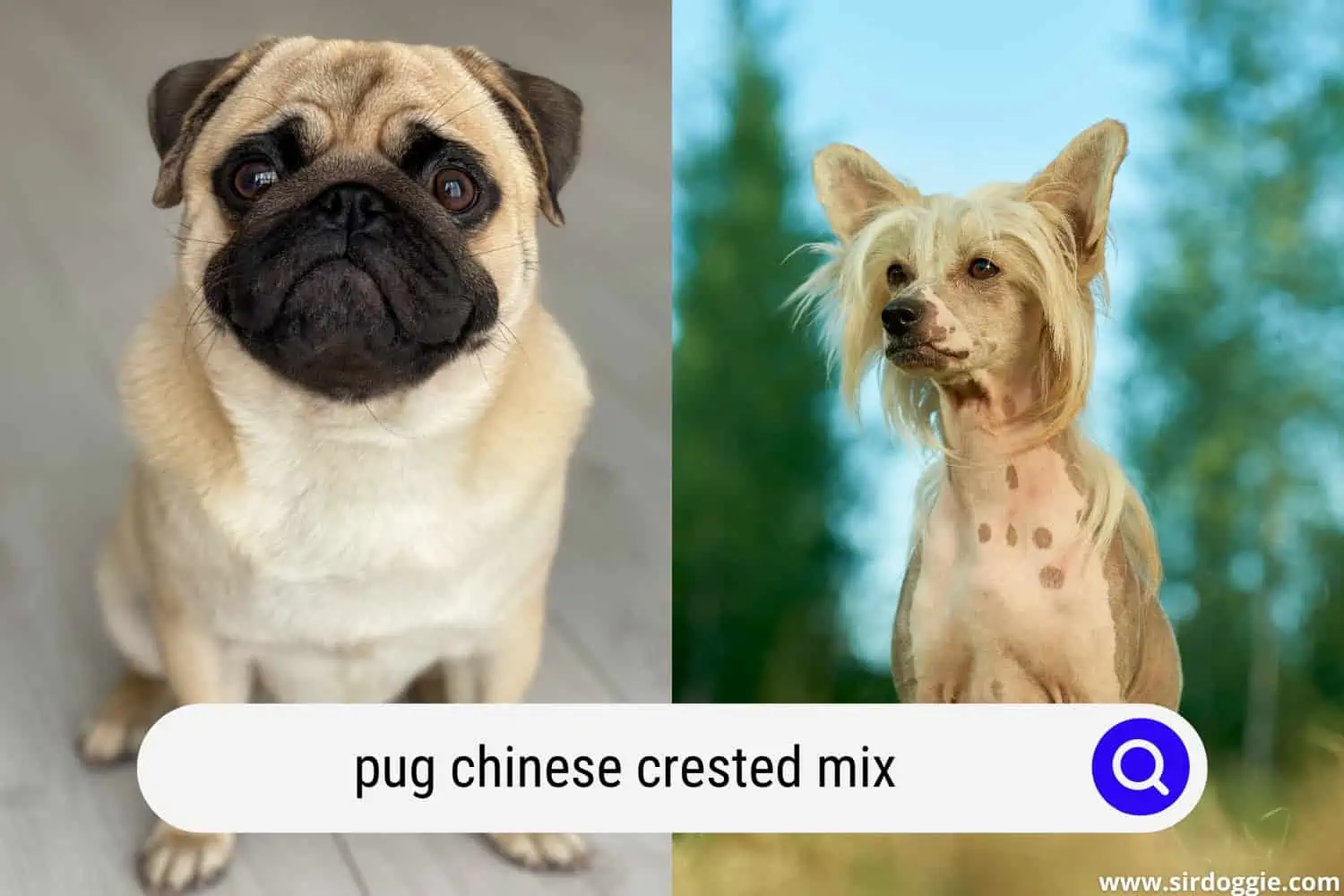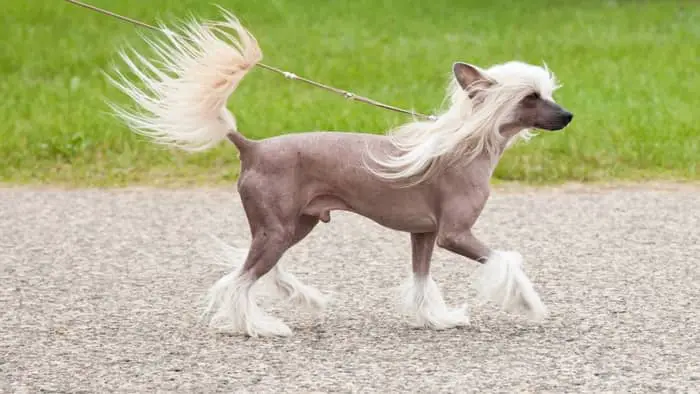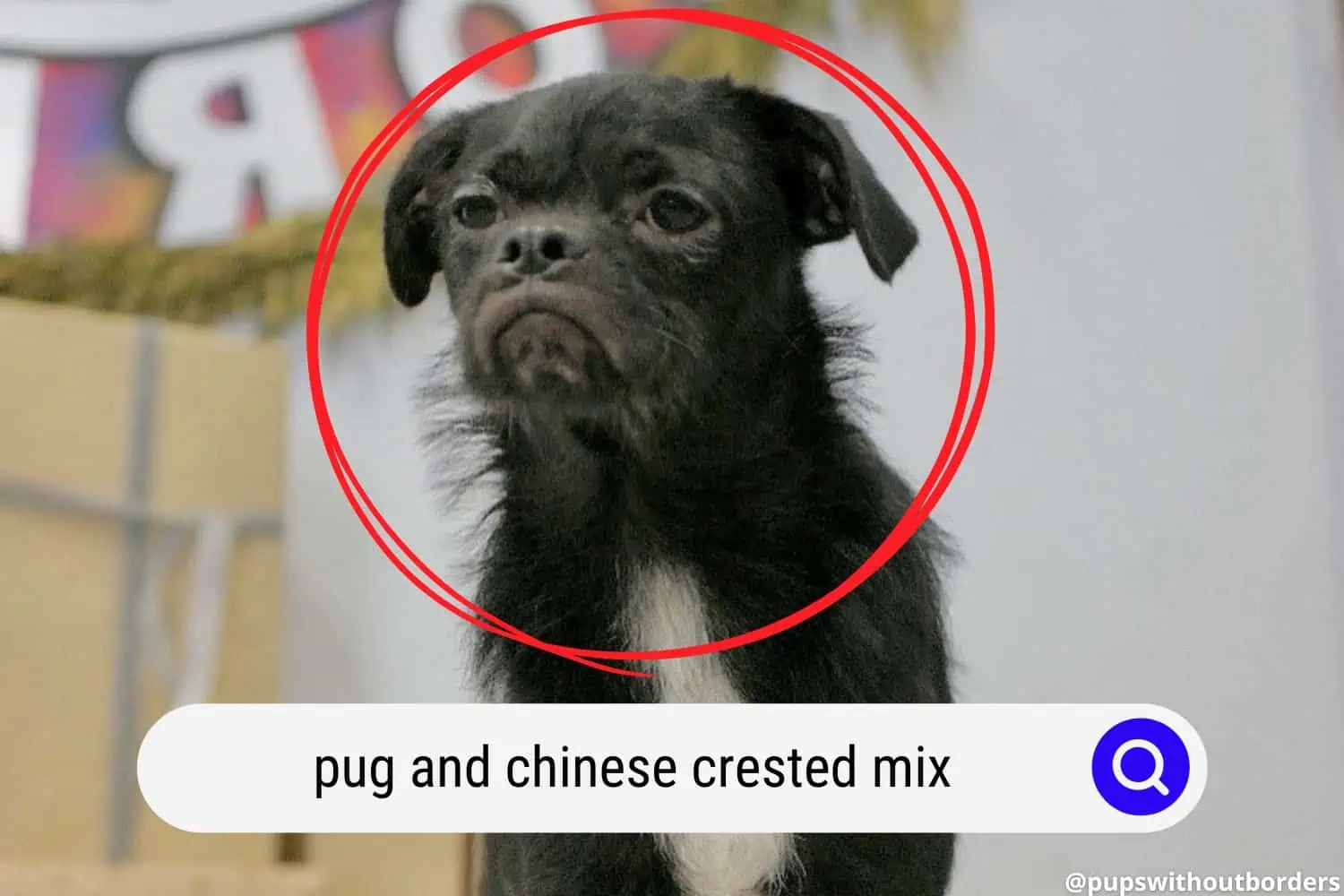The Pug Chinese Crested Mix
The Pug Chinese Crested mix combines two little cutie pies of the dog world – the Pug and the Chinese Crested Dog. This hybrid dog combines two popular toy dog breeds. They love to play games with their people.
Read on to learn all about them! But first, let’s delve into the world of the Chinese Crested Dog.

Related Reading: American Lo-Sze Pug vs Chinese Pug: US vs Asia, Who Is The Winner?
The Chinese Crested Dog
Despite their name, the DNA of this hairless breed indicates that they are related to the hairless dogs of Mexico. This dog breed is very old; statues of them have been dated back to ancient times.
The Chinese Crested Dog comes in the hairless variety, and a furry one called the Powderpuff. They are a relatively new breed, only being recognized by international kennel clubs in the 1980s and 1990s.
The hairless gene is dominant in Chinese Crested Dogs, and the hair gene is recessive. Some Chinese Crested Dogs carry the hairless gene – which in turn can be passed on to a Chinese Crested Pug mix, to create a hairless pug.
This breed has large, pointed ears (with hair, even if they are ‘hairless’), an apple-shaped head, a long muzzle, and a lean and dainty body. The legs are long for their size and the little feet are hairy. Sometimes the chest is too. They have curled tails with hairy tips. The Powderpuffs are generally white, and the hairless have white and gray hair. Chinese Crested Dogs have brown eyes. These small dogs only weigh 11 to 13 pounds. Their skin can be white/pink or gray/black.
Sadly for this breed, they often win “Ugliest Dog Competitions” – but, beauty is in the eye of the beholder as they say!
Chinese Crested Dogs are playful and affectionate with their families and aloof with strangers. Like any dog, they can show fear-aggression to other animals and strangers if they are not properly socialized. Chinese Crested Dogs are alert and energetic.
Chinese Crested Dogs can live for up to 15 years if properly cared for. Health issues associated with this breed are retinal atrophy, acne, dental problems (all of their teeth are pointed canine teeth), and stifle luxation.
This dog is a popular breed among allergy sufferers because they are hypoallergenic.

Related Reading: What Do You Call A Group Of Pugs?
The Pug and Chinese-Crested Mix: Meet The Pugese!
Now we know all about the Chinese Crested Dog, we can understand the Pugese a little better.
The origins of the Pug Chinese-Crested mix are unknown, but we do know that hybrid dogs, also called ‘designer dogs’, have been around since the 1970s.
The Pug and the Chinese Crested Dog make a good match because being toy companion breeds, the Pugese makes for a small and companionable dog that does well living in small spaces like an apartment.
Pugs tend to shed a lot of hair, so by combining the endearing nature of the Pug with the hairless-ness of the Chinese Crested Dog, it is possible to end up with a hairless pug.
A Hairless Pug?
Yes, the hairless pug is real and they are adorable! Check out Mia, who has her own Instagram page. One owner of a hairless pug says that people are either horrified or in love when they meet her dog for the first time!
More Chinese Crested Pug Mix Information
Pugese Looks
The Pugese is, on average, 10 to 13 inches tall at the shoulder when they are adults, and weigh somewhere between 11 and 15 pounds.
The Chinese Crested Pug mix combines a stout and rotund breed with a fine-boned breed. The Pugese will have more flesh on it than a Chinese Crested Dog, but they will not usually be as rounded as a Pug. Some have hair and some do not – it all comes down to each individual in any litter. They will have brown protuberant eyes since both Pugs and Chinese Crested Dogs do. The Pug and Chinese-Crested mix has fewer skin folds than the Pug, thanks to the Chinese Crested Dog genes. Most of them will have a medium-sized head and a slightly longer snout than a purebred Pug. The Chinese Crested Pug mix often has half-cocked ears.
Pugese Temperament
This mix is a good companion dog, clownish at times, yet ‘proper’ too in some circumstances. They are attached to their families but shy with strangers. The Pugese should not be left home alone too much because they get separation anxiety.
Because they are so small, any affection you show them must be quiet and gentle otherwise they may take fright. For this reason, they may be unhappy near little kids or larger dogs.
Pugese Exercise and Training
The Pugese is happy with one walk per day for around half an hour. Cover their skin so they don’t get sunburnt or get too cold. If they have the Pug pushed-in face then don’t walk them in hot weather because they struggle to breathe. They will love playing at home too when going out isn’t an option.
The Chinese Crested Pug mix can take longer to toilet train than other breeds so please be patient with them – it can take them six months to get it right. This is because Pugs have bladders that take longer to fully develop than most other breeds.
Pugese Health Concerns
Joint problems, eye problems (‘dry eye’ and glaucoma), skin disorders and diseases, and teeth problems (i.e. dental disease) are all a possibility with the Pug and Chinese Crested mix. Get a puppy vet-checked before committing to ownership, so that you can make an informed decision and get some expert advice throughout the dog’s lifespan if you decide to proceed.

Summary
The Pug and Chinese-Crested mix combines two small companion dog breeds. They can have fur, or be hairless. This hybrid dog is a happy and playful little friend. They feel most happy when they are home with their human companion. The Pugese do well living in small spaces like apartments, they love being at home, and they make good watchdogs!
So if you are a bit of a homebody then the Pugese may be just the dog for you.
Related Reading: Japanese Chin Pug Mix: A Modern Asian Story

Family Dog Expert Author
Hi there! I’m Stuart, a devoted dog lover and family dog expert with over a decade of experience working with our furry companions. My passion for dogs drives me to share my knowledge and expertise, helping families build strong, loving bonds with their four-legged friends. When I’m not writing for SirDoggie, you’ll find me hiking, playing with my beautiful dog, or studying music.